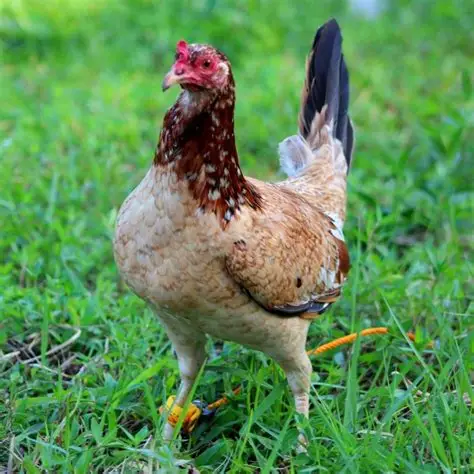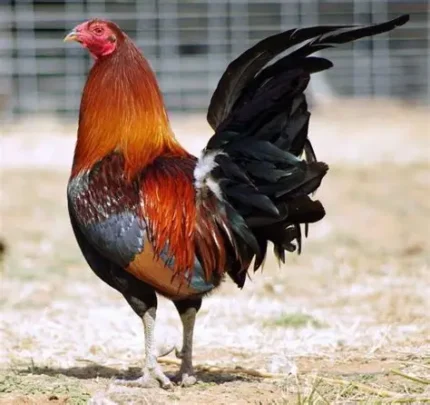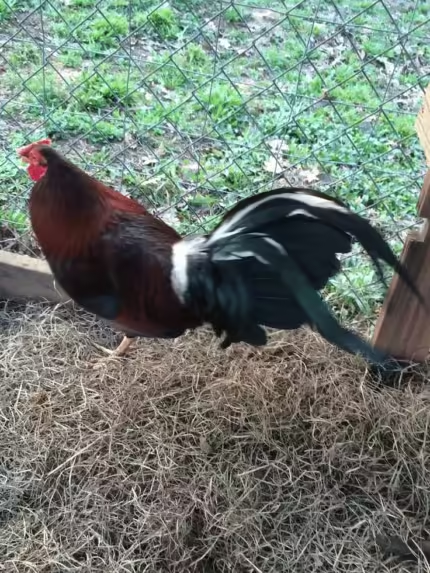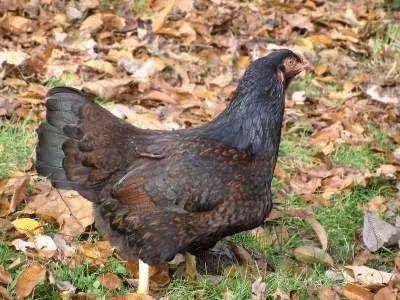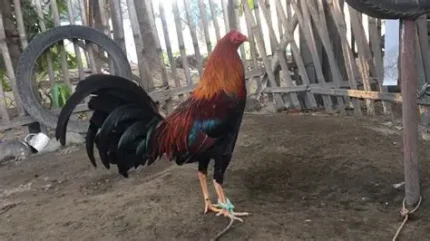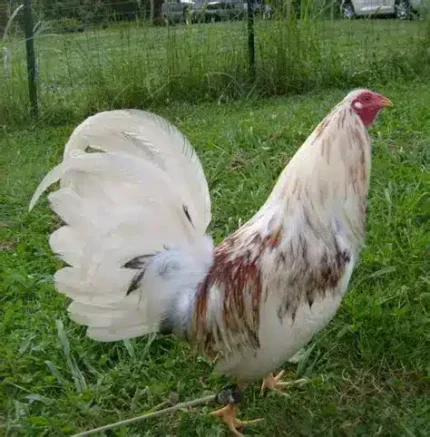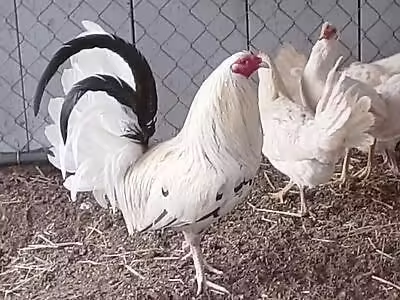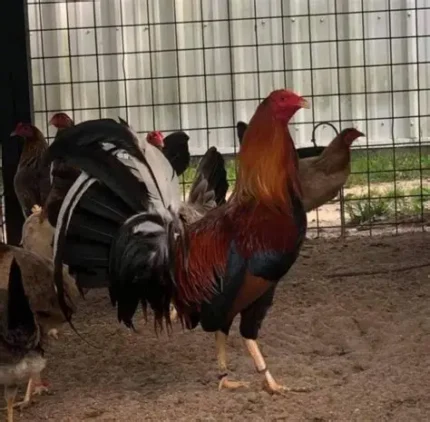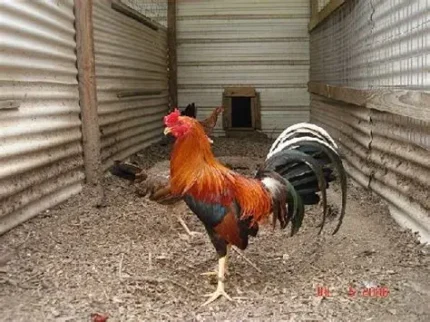

Kelso Hen For Sale
$200.00
Looking for a top-quality Kelso Hen for Sale? At Ocellated Turkey Hub, we offer premium Kelso hens known for their strength, agility, and excellent breeding potential. These hens are ideal for game fowl enthusiasts seeking to improve their stock with reliable genetics. Explore our selection and bring home a hardy Kelso hen today!
Kelso Hen for Sale: Key Features to Look For
Are you in the market for a Kelso Hen for Sale? These poultry birds are known for their endurance and fighting game attributes, making them a sought-after choice for livestock enthusiasts. In this post, we will dive into the essential traits to look for when selecting Kelso hens, explore how to evaluate breeders for quality, and discuss the nutritional needs critical to their health. By addressing these key points, you can avoid common pitfalls in chicken ownership and ensure a thriving addition to your flock. Let’s get started.
Identify the Most Desired Traits in Kelso Hen for Sale
When considering Kelso Hen for Sale, focus on key traits that indicate quality stock. Assess size and weight characteristics to ensure they meet poultry standards. Review color patterns and feather quality for visual appeal and health. Evaluate temperament and behavior to ensure a friendly personality. Check egg production rates for reliable output. Investigate health history and genetic background for longevity. Lastly, consider the hen’s adaptability to your environment to make the best choice for your needs.
Assess the Size and Weight Characteristics of the Kelso Hen for Sale
When assessing the size and weight characteristics of Kelso Hen for Sale, buyers should prioritize birds that exhibit a strong build and healthy weight. A typical pure Kelso hen should weigh around 5 to 7 pounds, allowing for optimal egg production and overall resilience. For those operating a farm focused on poultry, selecting hens within these weight parameters can lead to improved productivity and lower maintenance costs.
It is also important for potential purchasers to view the size of the hen in relation to its overall body structure. The Kelso features a distinctive blueface, which is a hallmark of this breed. Hens with well-proportioned size and robust weight tend to adapt better to various environments, making them ideal for farmers seeking reliable and sturdy stock that can thrive across different conditions.
Review Color Patterns and Feather Quality for Appearance
When evaluating the visual appeal of Kelso Hen for Sale, color patterns and feather quality play a significant role. This breed often features vibrant hues, and consistent patterns can indicate healthy genetics. Buyers should look for hens with smooth, glossy feathers, which not only enhance their appearance but also reflect good health, ensuring the birds are less susceptible to issues that could affect performance and vitality.
The comb structure of Kelso hens should also be examined, as it is another indicator of breed quality. A well-formed comb contributes to the overall look and can influence the hen’s ability to regulate body temperature. By focusing on these characteristics, prospective buyers can make informed choices, ensuring they select Kelso Hen for Sale with excellent genetics and suitable traits for both decorative and productive purposes, whether for egg production or participation in blood sport events.
Evaluate Temperament and Behavior of the Kelso Hen
The temperament and behavior of Kelso hens are crucial for anyone considering these birds for their farm. Generally, these hens exhibit a calm and friendly demeanor, making them suitable for families and smallholdings. Their sociable nature allows them to coexist peacefully with other poultry, which is beneficial for maintaining a harmonious environment at a hatchery or home farm. Prospective buyers often appreciate this trait as it minimizes stress among the flock, contributing to overall health and egg production.
Check Egg Production Rates for Reliable Output
When evaluating Kelso Hen for Sale, one of the most critical factors to consider is their egg production capacity. Kelso hens are known for their reliable output, with a typical laying rate of around 250 to 300 eggs per year. This high productivity makes them an excellent choice for farmers who rely on consistent egg supply. Prospective buyers should inquire about specific egg-producers’ backgrounds to ensure they select the right stock for their needs.
In addition to overall laying rates, it is beneficial to analyze the quality of the eggs produced by these birds. Quality traits such as shell thickness and yolk color can indicate the health and genetic quality of the fowl. Engaging with reputable breeders allows buyers to gain insights into the hen’s lineage and egg performance history. This knowledge helps ensure that the Kelso hens chosen will not only provide a steady supply of eggs but also meet the desired standards for size and quality.
Investigate Health History and Genetic Background
Investigating the health history and genetic background of Kelso hens is essential for potential buyers. Many choose to analyze personal data related to health records, ensuring that the birds lack common poultry diseases. Understanding the bloodlines of the hens can provide insights into their overall health and longevity. Buyers should seek out breeders who are transparent about the health history of their stock, particularly looking for traits passed down from asil chickens or other desirable breeds, which can enhance both performance and resilience.
Moreover, examining the genetic background allows buyers to select hens that meet specific production goals. Knowledge of the stag and its lineage can indicate breeding quality, often resulting in improved plumage and performance characteristics. Buyers who prioritize genetic information can find stock that performs optimally in various environments, making informed decisions that align with their farming objectives and expectations for quality egg production.
Consider the Kelso Hen’s Adaptability to Your Environment
Adaptability is a vital trait when selecting Kelso hens, especially for those considering them as pets or for farm production. These birds thrive in a variety of climates and settings, showcasing resilience that benefits both casual keepers and serious farmers. Buyers should evaluate their specific environment to ensure that the Kelso Hen for Sale can comfortably integrate, whether in an urban setting or on a larger homestead.
Consulting with previous owners or breeders can offer valuable insights into how Kelso Hen for Sale perform in differing conditions. Understanding how these birds react to temperature fluctuations, housing arrangements, and space can aid potential purchasers in making informed decisions. This knowledge helps ensure that the selected hens will not only adapt well but also contribute positively to the overall experience of keeping them as pets or in a farming operation.
Evaluate Breeders and Their Reputation for Quality Hens
Researching trusted breeders with positive reviews is essential when looking for Kelso Hen for Sale. Inquiring about breeder practices and standards, reviewing testimonials from previous customers, and assessing post-purchase support can provide valuable insights. Visiting breeders to inspect hens and facilities, along with comparing prices from different sources, ensures buyers make informed decisions and find quality stock.
Research Trusted Breeders With Positive Reviews
Researching trusted breeders with positive reviews is crucial for anyone interested in purchasing Kelso Hen for Sale. Quality breeders typically have a strong online presence, showcasing customer feedback and testimonials that highlight their reliability and the health of their chickens. Engaging with fellow poultry enthusiasts in forums or social media groups can also help identify reputable sources, allowing potential buyers to make informed choices based on shared experiences.
Additionally, visiting breeders in person can provide an opportunity to observe the conditions in which the hens are raised. This firsthand assessment allows buyers to evaluate the cleanliness of the facilities and the overall well-being of the birds. By prioritizing breeders who demonstrate a commitment to high standards and receive consistent positive feedback, individuals can enhance their chances of acquiring healthy and productive Kelso hens.
Inquire About Breeder Practices and Standards
Inquiring about breeder practices and standards is essential when searching for quality Kelso hens. Reputable breeders prioritize the health and well-being of their birds, implementing biosecurity measures to prevent disease and ensuring that hens are raised in clean, safe environments. Potential buyers should ask about the feeding regimen, housing conditions, and veterinary care provided to the flock, as these factors directly influence the quality and productivity of the hens.
Moreover, understanding a breeder’s breeding philosophy can provide insights into the quality of the stock. Experienced breeders often focus on specific traits, such as egg production rates and temperament, which align with buyers’ needs. Engaging in discussions with breeders about their practices will not only build trust but also help prospective owners feel confident in their choice of Kelso hens that are healthy and well-cared for.
Review Testimonials From Previous Customers
Reviewing testimonials from previous customers can provide valuable insights into the experience of purchasing Kelso hens. Many buyers share their stories regarding the health and productivity of the hens, which helps prospective purchasers gauge the quality of the stock offered by a breeder. Positive feedback regarding the hens’ adaptability and temperament can also assist in making informed choices that align with their specific needs.
Customers often highlight not only the hens’ performance but also the breeder’s commitment to their animals. Testimonials that discuss the professionalism and support provided by breeders can guide potential buyers in selecting a reliable source for their Kelso hens. By focusing on feedback from former clients, individuals can feel more confident in their investment, ensuring they acquire hens that will thrive and contribute positively to their poultry operations.
Assess Breeder Support After Purchase
Assessing breeder support after purchasing Kelso hens is vital for ensuring a smooth transition into a new environment. Reputable breeders will offer guidance on the care and management of the hens, addressing common concerns about housing, feeding, and health checks. This ongoing support not only helps buyers maintain the wellbeing of their flock but also fosters a strong relationship with the breeder, enhancing the overall experience of raising Kelso Hen for Sale.
Furthermore, access to breeder support can be a significant advantage when facing challenges, such as disease management or behavioral issues. Active communication channels, whether through phone consultations or online resources, allow buyers to seek advice and solutions quickly. By choosing a breeder committed to continued assistance, poultry enthusiasts can feel more confident in their abilities to nurture healthy and productive Kelso Hen for Sale while building a sustainable flock.
Visit Breeders to Inspect Hens and Facilities
Visiting breeders to inspect Kelso hens and their facilities provides potential buyers an opportunity to assess the overall quality and health of the stock. A walk-through can reveal cleanliness and proper care practices, which are essential indicators of a reputable operation. Observing hens in their environment allows buyers to evaluate their behavior, size, and feather quality firsthand, ensuring that they make informed decisions about which birds to purchase.
During these visits, individuals can engage directly with the breeders, asking questions regarding their breeding practices, health management protocols, and feeding regimens. This interaction helps establish trust and provides insights into the breeder’s commitment to quality care. By choosing a breeder that demonstrates transparency and professionalism, buyers increase their chances of acquiring healthy, productive Kelso hens that meet their specific needs.
Compare Prices From Different Sources for Fairness
When seeking Kelso hens for sale, comparing prices from various sources is essential to ensure fairness in the purchasing process. Buyers should consider the significant variance in pricing, which can stem from factors such as the breeder’s reputation, the hen’s health status, and the quality of care provided. By gathering information from multiple breeders, potential purchasers can identify reasonable price ranges that reflect the value of the hens they plan to acquire.
Furthermore, understanding what influences pricing helps buyers make informed decisions. For instance, a reputable breeder may charge more due to superior genetics and proven health records, while lower prices might indicate compromised quality or insufficient care. Therefore, assessing the cost in relation to the hen’s overall traits and the breeder’s practices creates a clearer picture, enabling buyers to select healthy Kelso hens that align with their expectations and budget.
Understand the Nutritional Needs for Kelso Hen
To ensure Kelso hens thrive, identifying essential nutrients for optimal health is vital. Understanding suitable feed types will support their growth and egg production, while recognizing signs of nutritional deficiencies can prevent health issues. Establishing effective feeding schedules, incorporating supplements as needed, and monitoring water intake will further enhance their overall well-being.
Identify Essential Nutrients for Optimal Health
Kelso hens require a balanced diet rich in essential nutrients to maintain optimal health and productivity. Key nutrients include proteins, which are vital for muscle development and egg production, as well as carbohydrates for energy. Additionally, vitamins and minerals such as calcium, phosphorus, and vitamin D are crucial for strong eggshells and overall well-being, ensuring the hens thrive in various environments.
Selecting the right feed is essential for meeting these nutritional needs. High-quality commercial poultry feeds are specifically formulated to support the growth and egg-laying capabilities of Kelso Hen for Sale. Regular monitoring of their diet and making adjustments based on their changing requirements can greatly enhance health and productivity, leading to a successful experience for any farmer or poultry enthusiast aiming to maximize their flock’s potential.
Learn About Feed Types Suitable for Kelso Hens
Choosing the right feed is essential for the health and productivity of Kelso hens. Typically, a high-quality layer feed that contains approximately 16-20% protein is ideal, as it supports both growth and egg production. These feeds are often fortified with necessary vitamins and minerals that help maintain the hens’ overall well-being and assist in producing strong eggshells.
In addition to layer feeds, incorporating grains such as corn and wheat can provide additional energy, especially during colder months. Poultry enthusiasts often find that supplementing with fresh fruits and vegetables helps improve both the nutrition and flavor of the hens’ diet, promoting their health and ensuring they remain active in their environment. Proper nutrition ultimately leads to better egg yield and healthier Kelso hens, making it a crucial aspect for anyone looking to purchase these birds.
Recognize Signs of Nutritional Deficiencies
Recognizing signs of nutritional deficiencies in Kelso hens is essential for maintaining their overall health and productivity. Common indicators include reduced egg production, poor feather quality, and weight loss. For example, hens lacking sufficient calcium may produce eggs with thin shells, which can lead to breakage and decreased laying rates, directly impacting the farmer’s output.
In addition to these visible signs, behavioral changes can also signal nutritional issues. Hens that exhibit lethargy or decreased activity levels may not be receiving adequate nutrients. By monitoring these signs and adjusting the diet accordingly, poultry keepers can improve the health and performance of their Kelso hens, ensuring they thrive and meet production goals effectively.
Establish Feeding Schedules for Best Results
Establishing a consistent feeding schedule for Kelso hens is crucial to ensure optimal health and egg production. Providing feed at the same times daily helps regulate their digestive system, leading to better nutrient absorption and overall well-being. Hens typically benefit from two main feeding sessions, one in the morning and one in the evening, allowing them to consume the necessary nutrients while also promoting a healthy routine.
Incorporating a feeding routine that includes high-quality layer feed ensures that Kelso hens receive the required protein and vitamins. Farmers often find that monitoring the hens’ intake and adjusting portion sizes based on their activity level can further enhance productivity. A well-structured feeding schedule not only supports the hens’ nutritional needs but also contributes to consistent egg yields, addressing the demands of those looking to purchase Kelso hens for reliable production.
Include Supplements to Enhance Diet as Needed
Incorporating supplements into the diet of Kelso hens can significantly enhance their overall health and egg production. Calcium and phosphorous supplements are particularly important as they contribute to strong eggshells, reducing the risk of breakage, which is crucial for those looking to maintain a consistent and reliable egg supply. Regularly assessing the hens’ dietary needs and adding these nutrients can lead to improved longevity and productivity.
Additionally, incorporating vitamins such as A, D, and E can further boost the hens’ immune systems and overall vitality. Poultry owners often find that the inclusion of probiotics in the feed promotes healthy digestion, thereby optimizing nutrient absorption. By being proactive in enhancing their diet with suitable supplements, buyers can ensure their Kelso hens thrive, fulfilling both aesthetic and production goals effectively.
Monitor Water Intake for Overall Well-Being
Monitoring water intake is crucial for maintaining the overall health of Kelso hens. Proper hydration directly influences their egg production rates and general well-being, making it essential for farmers to provide consistent access to clean, fresh water. Observing the hens’ drinking habits can help identify any changes in their health, such as dehydration, which may affect their productivity.
Analyze Space Requirements for Raising Kelso Hens
Assessing space requirements is essential when raising Kelso hens, as it directly impacts their comfort and productivity. Buyers should evaluate coop size to ensure adequate living conditions, plan outdoor spaces for free-ranging activities, and prioritize proper ventilation and lighting within coops. Organizing nesting areas for egg-laying, incorporating enrichment activities to reduce stress, and installing fencing to protect from predators are vital to maintaining a healthy flock.
Assess Coop Size for Comfortable Living Conditions
Assessing the coop size for raising Kelso hens is essential to ensure their comfort and well-being. A suitable space should accommodate at least 4 square feet per bird inside the coop, allowing them to move freely and establish a social hierarchy. Ensuring plenty of room can also reduce stress and conflicts among the flock, promoting healthier and more productive hens.
Additionally, the coop must include proper ventilation and sunlight to create a conducive environment for the Kelso hens. Adequate airflow prevents the buildup of ammonia and excess humidity while exposure to natural light encourages routine egg production. A well-designed coop that meets these requirements can make a significant difference in the overall development and quality of the flock.
Plan Outdoor Space for Free-Ranging Activities
Planning outdoor space for free-ranging activities is vital for the well-being of Kelso hens. This breed thrives when allowed to roam and forage, which contributes to better health and egg production. A secure area that offers at least 10 square feet per hen encourages natural behaviors, reduces stress, and fosters a more harmonious living environment.
Ensuring that the outdoor space is protected from predators is crucial. Installing sturdy fencing and providing shaded areas can enhance the hens’ safety while they enjoy their time outside. By creating an engaging outdoor space, farmers set the stage for Kelso hens to be active, promoting overall happiness and productivity in their flock.
Ensure Proper Ventilation and Lighting in Coops
Ensuring proper ventilation in coops is essential for the health of Kelso hens. Good airflow helps prevent the buildup of harmful gases, such as ammonia, which can occur from droppings. Properly designed ventilation systems allow fresh air to circulate while minimizing drafts, creating a comfortable environment that supports the well-being and productivity of these birds.
Lighting also plays a crucial role in managing the laying cycles of Kelso hens. Natural sunlight stimulates hormone production, influencing egg production rates. Incorporating windows or artificial lighting that mimics natural conditions can help maintain consistent light exposure, encouraging regular laying patterns and promising better overall health for the flock.
Organize Nesting Areas for Egg Laying
Organizing nesting areas for egg laying is vital for ensuring the comfort of Kelso hens and optimizing their productivity. Providing separate nesting boxes for each hen can encourage them to lay eggs in a secure and quiet environment, reducing stress and promoting consistent egg production. It is recommended that each nesting box is filled with clean straw or wood shavings to create a cozy space that hens find inviting and suitable for laying their eggs.
Proper placement of nesting areas also contributes significantly to the overall well-being of the flock. Nesting boxes should be located in a quiet part of the coop, away from high-traffic areas, to help hens feel safe while laying. Ensuring that these boxes are easily accessible for hen inspection while maintaining a calm atmosphere encourages hens to use them consistently, ultimately supporting higher egg yields and healthier birds.
Include Enrichment Activities to Reduce Stress
Including enrichment activities is essential for maintaining the well-being of Kelso hens and reducing stress. Activities such as providing perches, dust baths, and varied ground materials encourage natural behaviors like scratching and foraging. These stimulating environments not only improve the hens’ physical health but also enhance their mental engagement, leading to happier, more productive birds.
Incorporating toys and obstacles in the available space can foster curiosity and playfulness among the Kelso hens. Simple items like hanging vegetables or mirror reflections can keep the hens entertained and distracted from potential stressors within their environment. By prioritizing these enrichment activities, poultry keepers can ensure their Kelso hens remain active and healthy, ultimately supporting a more successful poultry operation.
Install Fencing to Protect From Predators
Installing secure fencing is essential for protecting Kelso hens from predators, which pose a significant risk to their safety and well-being. The fencing should be strong and tall enough to deter common threats such as raccoons and foxes, while materials should be durable to withstand outdoor conditions. Using a combination of sturdy wire and wooden posts can create an effective barrier that allows the hens to roam freely while minimizing the chance of being attacked.
Additionally, it is important to ensure that the fencing extends underground to prevent smaller animals from burrowing underneath. A depth of at least a foot is advisable for added security. By investing in appropriate fencing, poultry keepers can create a safe environment for their Kelso hens, promoting healthier and more productive birds by reducing stress related to potential threats from predators.
Examine the Costs Involved in Purchasing and Caring for Hens
Purchasing and maintaining Kelso hens involves several critical financial considerations. Buyers should budget for the initial purchase price while calculating ongoing feed and care expenses. Regular veterinary checkups must be included in financial planning, alongside the costs for necessary equipment and coop setup. It’s also vital to plan for unexpected health issues and related costs. Finally, comparing long-term expenses with expected egg production will provide insight into the overall investment potential. Each of these factors contributes to a comprehensive understanding of the financial commitment involved in raising Kelso hens.
Budget for Initial Purchase Price of Kelso Hens
When budgeting for the initial purchase price of Kelso hens, prospective buyers should first consider the varying price ranges that reputable breeders offer. Typically, a healthy Kelso hen can cost between $15 to $50 each, depending on factors such as age, lineage, and breeding practices. Understanding these aspects will help buyers make informed decisions that align with their goals, ensuring they invest in quality stock that is likely to yield better performance and productivity.
Incorporating the initial purchase price into the overall budget is essential for anyone looking to raise Kelso hens. It is advisable to account for potential extra costs such as transportation fees, which can vary based on distance from the breeder, and any associated health checks or vaccinations. By planning for these expenses alongside the purchase price, buyers can create a more accurate financial plan, ultimately leading to a successful and sustainable venture in poultry farming.
Calculate Ongoing Feed and Care Expenses
Calculating ongoing feed and care expenses for Kelso hens is essential for prospective poultry owners. Typically, the average feed cost can range from $15 to $30 per hen each month, depending on dietary choices and the quality of feed provided. By budgeting for this expense, individuals can ensure their hens receive the necessary nutrients to support optimal health and egg production, which is vital for maintaining a productive flock.
Additionally, regular healthcare and maintenance costs should not be overlooked. Annual veterinary checkups, vaccinations, and potential treatments for common poultry ailments can add up, generally costing around $50 to $100 per bird each year. Understanding these financial commitments enables buyers to make informed decisions when investing in Kelso hens, ensuring they are well-prepared for both initial and ongoing expenses associated with responsibly managing their flock.
Include Veterinary Checkups in Financial Planning
Including veterinary checkups in financial planning is essential for anyone purchasing Kelso hens. Regular health assessments help identify potential health issues early, which can minimize costly treatments later. By budgeting for routine veterinary visits, poultry owners can ensure their hens remain healthy, leading to consistent egg production and overall flock performance.
Veterinary care often includes vaccinations and preventative treatments that support the long-term well-being of Kelso hens. Proactive health management not only improves the birds’ resilience but also contributes to their productivity and quality of life. Understanding these costs upfront allows buyers to allocate appropriate funds, ensuring they provide the necessary care for their hens while optimizing their investment in poultry farming.
Factor in Equipment and Coop Costs
Considering the initial equipment and coop costs is vital when purchasing Kelso hens. A well-constructed coop ensures safety and comfort for the hens, requiring an investment that can range from a few hundred to several thousand dollars, depending on design and materials. This setup not only protects against predators but also provides a friendly environment that promotes health and productivity in the birds, ultimately facilitating a successful poultry operation.
Moreover, buyers should factor in ongoing costs related to equipment maintenance and necessary supplies. Regular expenses may include bedding materials, feeding tools, and water systems that all contribute to the overall well-being of Kelso hens. By budgeting for both the initial and recurrent costs associated with equipment and coop maintenance, poultry enthusiasts can ensure they are fully prepared for raising these birds while maximizing their investment in quality egg production.
Plan for Unexpected Health Issues and Costs
Planning for unexpected health issues and costs is essential when investing in Kelso hens. Hens, like all animals, can experience various health challenges throughout their lives. By setting aside a budget for veterinary care, including vaccinations and emergency treatments, poultry owners can protect their investment and ensure the well-being of their flock. This proactive approach contributes to maintaining a healthy and productive henhouse.
In addition to regular veterinary expenses, unforeseen issues such as illness or injury can arise at any time. Farmers should consider purchasing first-aid supplies and have a contingency plan in place for unexpected health situations. By being prepared, owners can minimize stress on the birds and reduce the impact on egg production, ultimately leading to a more sustainable and successful poultry operation with well-cared-for Kelso hens.
Compare Long-Term Costs With Egg Production
When evaluating the long-term costs associated with raising Kelso hens, prospective poultry owners must consider both the initial investment and ongoing expenses against their expected egg production. A well-managed flock can yield 250 to 300 eggs yearly per hen, which significantly contributes to the operation’s overall profitability. For instance, if a farm invests in quality hens and maintains them efficiently, the return on investment from consistent egg sales can outweigh the costs related to feed, veterinary care, and housing, making Kelso hens a sound choice for egg producers.
In assessing long-term viability, it is essential to account for both direct and indirect costs, including feed prices, coop maintenance, and health care. As Kelso hens thrive with proper nutrition and care, their productivity can lead to sustainable profits. By understanding the relationship between these costs and egg production rates, poultry keepers can make informed decisions that enhance their farming operations and ensure financial success over time.
Prepare for Integration Into Your Existing Flock
Understanding the behavioral dynamics of new Kelso hens is crucial for a successful integration into an existing flock. Gradual introduction techniques can help ease their transition, while monitoring social interactions for signs of conflict ensures harmony among the birds. Providing separate space initially promotes comfort and encourages the establishment of proper pecking order, while evaluating health observations during integration helps identify any issues early on.
Understand Behavioral Dynamics of New Hens
Understanding the behavioral dynamics of new Kelso hens is essential for a successful transition into an existing flock. New birds may initially display signs of stress as they adapt to their new environment. Observing interactions between the newcomers and established hens can help identify potential conflicts, allowing owners to intervene early if aggressive behaviors arise, thus maintaining harmony within the flock.
Integrating new Kelso hens requires a gradual approach to minimize stress and establish a stable social structure. For instance, housing newcomers in a separate space allows them to acclimate while still being visible to the existing flock. This separation fosters comfort, ensuring each hen becomes familiar with the other’s presence before direct interactions, ultimately promoting a smoother integration process.
Implement Gradual Introduction Techniques
To successfully integrate new Kelso hens into an existing flock, employing gradual introduction techniques is vital. This process begins by keeping the new hens in a separate enclosure near the established flock, allowing them to see and hear each other without direct contact. Such an environment helps ease the newcomers’ stress while enabling the established birds to grow accustomed to their presence, which is essential for fostering a peaceful coexistence.
After a few days of separation, introducing the hens in controlled circumstances is advisable. Supervising interactions while providing ample space can prevent aggression and disputes as each bird establishes its place within the social hierarchy. Monitoring their behavior during this crucial phase allows poultry keepers to address any signs of conflict promptly, ensuring a harmonious integration of the Kelso hens into their new home.
Monitor Social Interactions for Signs of Conflict
Monitoring social interactions among Kelso hens is crucial for maintaining a peaceful flock environment during integration. Observers should look for signs of aggression, such as pecking or chasing, which can indicate disputes over territory or hierarchy. By keeping a close eye on interactions during the initial introduction phase, one can address potential conflicts early, ensuring a smoother transition for the newcomers and the established birds.
It is also beneficial to assess how the established hens respond to the newcomers. If established hens display dominance or significant territorial behavior, separating the two groups temporarily can reduce stress and help ease the integration process. This attention to social dynamics ultimately contributes to a harmonious flock, significantly benefiting both egg production and the overall health of the Kelso hens.
Provide Separate Space Initially for Comfort
Providing a separate space for new Kelso hens during the initial integration phase is essential for their comfort and well-being. This designated area allows the newcomers to acclimate to their surroundings without immediate pressure from established flock members. Such arrangements help reduce stress and anxiety, giving the hens the opportunity to explore their new environment at their own pace.
During this adjustment period, the separate space should be equipped with adequate food, water, and shelter to ensure the newcomers’ needs are met. It is beneficial for the other chickens to see and hear the new hens, as this gradual exposure fosters familiarity while maintaining a safe distance. By implementing these practices, poultry owners can facilitate a smoother integration process, ultimately leading to a harmonious and productive flock.
Encourage Proper Pecking Order Establishment
Encouraging a proper pecking order establishment within a flock of Kelso hens is vital to maintaining peace and productivity. When introducing new hens, it is essential to allow established birds to assert their positions gradually, ensuring that newcomers do not face excessive aggression. This approach can be facilitated by creating plenty of space during interactions, allowing each hen to find its place without feeling threatened or overwhelmed.
Creating an environment that promotes the natural hierarchical structure helps minimize stress among the birds, which can, in turn, enhance egg production and overall flock health. Observing the hens closely during the integration process can identify any significant conflicts, enabling timely interventions if needed. By prioritizing a smooth pecking order establishment, poultry owners can foster a harmonious living situation that benefits both new and established Kelso hens.
Evaluate Health Observations During Integration
Evaluating health observations during the integration of Kelso hens into an existing flock is crucial for ensuring the overall well-being of both new and established birds. New hens should be closely monitored for any signs of stress or illness, such as lethargy or unusual feather loss. By keeping an eye on these health indicators, poultry owners can address potential issues early, minimizing the risk of spreading any health concerns throughout the flock.
In addition to monitoring individual health, observing interactions among the hens is essential for identifying any behavior that could indicate stress-related health problems. For example, established hens may show signs of dominance that lead to pecking or bullying, which not only affects the new hens’ stress levels but can also compromise their health. By actively assessing both health and social dynamics during this integration phase, poultry keepers can create a harmonious environment that promotes health and productivity within the flock.
Conclusion
Choosing the right Kelso hens is essential for successful poultry farming. Focus on critical traits such as size, weight, temperament, and egg production to ensure you acquire the best stock. Investigating breeder practices, health history, and adaptability will further enhance your chances of raising healthy and productive hens. By taking these factors into account, you will make informed decisions that lead to a thriving poultry operation.
